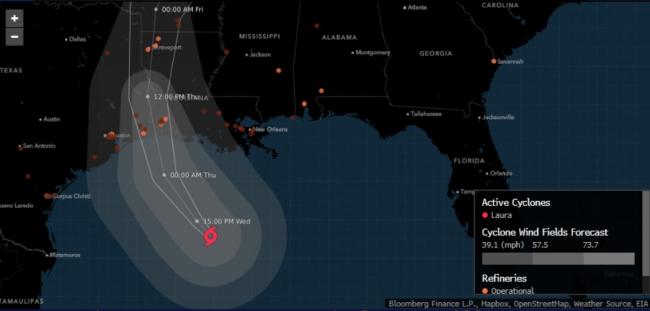(Bloomberg) -- America’s fast-growing petrochemical and refining network on the Gulf Coast is about to get its biggest test as it braces for a direct hit from Hurricane Laura.
The Category 4 storm is expected to slam into the Gulf Coast in the early hours of Thursday with devastating winds and a huge storm surge. While Houston will likely escape the worst of the hurricane’s impact, parts of Texas and Louisiana that have seen massive investment in recent years from the energy industry won’t be so lucky.
The stretch of coastline that will feel Laura’s impact accounts for about a quarter of U.S. oil refining capacity and half of North America’s production of ethylene, a key plastic raw material, according to Independent Commodity Intelligence Services, not to mention newly built liquefied natural gas export terminals. The rapid growth of petrochemical facilities over the past decade, fueled by the U.S. shale boom, has raised the potential for fatalities, as well as vast financial and environmental damage.
The area, encompassing the cities of Beaumont and Port Arthur in Texas and Lake Charles in Louisiana, is in for a “night of hell,” said Jeremy Pafford, head of North America market development at ICIS. “It will have a catastrophic effect on the plants that are there.”
This coastline is no stranger to hurricanes and their impact on the energy and chemicals sector. In 2017, an Arkema SA (OTC:ARKAY) chemical plant about 25 miles east of Houston suffered a fire and explosion after it was flooded by Hurricane Harvey.
But Laura could be the strongest storm to hit Louisiana in more than 160 years, and the resulting damage could be unprecedented given the vast economic growth in the area over the last decade.
The expected storm surge could leave Lake Charles -- home to several chemical plants including those run by Sasol (NYSE:SSL) Ltd., Phillips 66 (NYSE:PSX), and Westlake Chemical (NYSE:WLK) -- under 15 feet (4.5 meters) of water, according to the National Weather Service.
Beaumont and Port Arthur are also in Laura’s central cone and likely to experience extensive flooding as water rushes inland. Motiva Enterprise runs the U.S.’s biggest refinery in Port Arthur, while Exxon Mobil Corp (NYSE:XOM). has a large refining and petrochemical complex in Beaumont.
Cheniere Energy (NYSE:LNG) Inc.’s Sabine Pass LNG terminal, the country’s largest, sits right on the Louisiana coast and Cameron LNG, a $10 billion facility majority-owned by Sempra Energy (NYSE:SRE), is also nearby. They account for just over half of U.S. LNG export capacity and about 8% of global capacity, according to company and BloombergNEF data.
Most of these facilities have been shut and personnel removed to prepare for the storm.
The LNG terminals are designed to withstand Category 5 hurricane winds, but depending on the exact path the storm takes, the main concern may be the impact of the storm surge, which Louisiana Governor John Bel Edwards said in a press briefing Wednesday may be the biggest the state has seen in decades.
Unlike the newly-built LNG terminals, the dozens of refineries and some of the petrochemical plants that dot the Texas and Louisiana coast have been through decades of storms. The last new refinery was built in the late 1970s; while many plants have undergone upgrades and expansions, some of their equipment is old.
An explosion at a chemical plant in Port Neches in November marked the fourth major incident at a Gulf Coast facility that year. Port Neches is now forecast to be within the cone when Laura makes landfall.
The area’s facilities “are designed to take a bomb hit, and they’re designed to withstand very high winds,” said Jeff Branick, the county judge of Jefferson County, which encompasses Port Neches, Port Arthur and Beaumont. “This storm is certainly going to be worse than Rita or Ike or Harvey as far as wind speed and intensity goes.”
So far the impact on markets has been relatively muted. U.S. refineries were already running at just 81% capacity due to the Covid-19 pandemic, down from 96% at the same time last year, according to Tudor Pickering Holt & Co. Similarly, the Sabine Pass and Cameron LNG terminals were also running at low capacity.
Unlike in 2017, when Hurricane Harvey significantly cut Gulf coast refining supply, this time around, product inventories in the region are “well above normal,” Neil Mehta, an analyst at Goldman Sachs (NYSE:GS), wrote Tuesday in a note to investors.
“A lot of the oil and gas infrastructure is pretty robust, but Laura seems like a big powerful storm,” said Jason Feer, global head of business intelligence at Poten & Partners. “The weak link is usually fairly mundane things like compression stations, above ground pipelines, gathering systems, power for the various installations.”
©2020 Bloomberg L.P.

